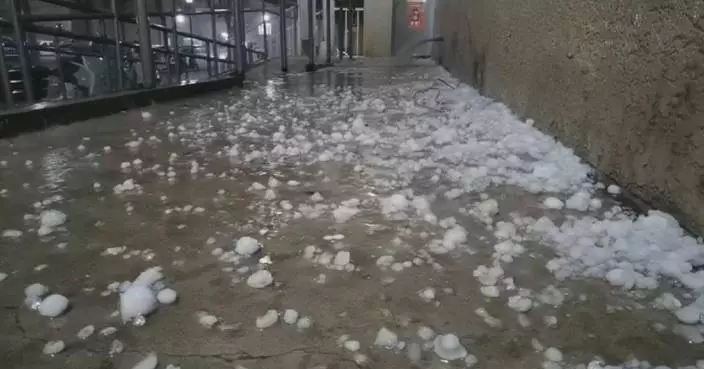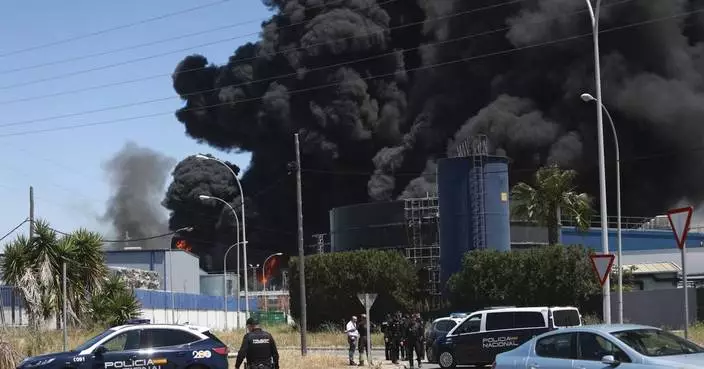CHICAGO (AP) — The Chicago Blackhawks placed defenseman Connor Murphy on injured reserve Saturday because of a groin injury.
The 31-year-old Murphy hasn't played since he logged more than 19 1/2 minutes in a 6-2 loss to St. Louis in the Winter Classic on Dec. 31. He has one goal and 12 assists in 38 games this season.
Murphy's IR stint was made retroactive to the loss to the Blues, and interim coach Anders Sorensen said he didn't have a timeline for his return.
“It's longer than a couple days,” he said.
Defenseman Alec Martinez was activated from IR after being shelved by a neck injury. The 37-year-old Martinez returned to the lineup for Saturday night's 4-3 loss to Edmonton, replacing Wyatt Kaiser.
Sorensen said Martinez "looked good, kind of made some plays under pressure that we talked about.”
Martinez picked up an assist in his first game since Dec. 7. He said he was sidelined because of some residual effects from taking a puck to his neck.
“They were worried about vascular issues and things like that,” he said. “It was a bit of a scary thing, obviously going to the hospital and everything. But I’m thankful the doctors handled it appropriately. All the ambulance staff, all the paramedics. There’s protocols in place for a reason, and I’m very grateful of those guys handling it in such a good manner.”
Veteran forward Craig Smith missed his second straight game with a back injury. Sorensen described Smith as day to day.
Chicago (14-27-2) has lost eight of 10.
After Friday night's 5-3 loss at Detroit, Sorensen adjusted his lines for the matchup with the Oilers. The changes included putting Lukas Reichel, 22, on a line with Frank Nazar and Colton Dach, 22.
Reichel, Nazar and Dach are three of the team's youngest players. Nazar turns 21 on Tuesday.
“There were some good moments,” Sorensen said of the line's performance against Edmonton. “There was some moments where we got to improve on. Just understanding who you’re playing against and things like that, the importance of ... managing pucks against those guys. But I liked some of the things that they did.”
AP NHL: https://apnews.com/hub/NHL

Chicago Blackhawks defenseman Connor Murphy arrives for the NHL Winter Classic outdoor hockey game featuring the Blackhawks and St. Louis Blues at Wrigley Field, Tuesday, Dec. 31, 2024, in Chicago. (AP Photo/Erin Hooley)
MINNEAPOLIS (AP) — Julius Randle scored 29 points on 13-for-18 shooting to send the Minnesota Timberwolves to the Western Conference finals for the second straight year with a 121-110 victory over the Golden State Warriors in Game 5 on Wednesday night.
Anthony Edwards had 22 points and 12 assists for the sixth-seeded Wolves, who will face the Denver-Oklahoma City winner next. They could get five days off, if the Nuggets beat the Thunder on Thursday to force a Game 7 in the other West semifinal series.
Brandin Podziemski had a playoff career-high 28 points for the Warriors, who again played without star Stephen Curry because of the hamstring strain that forced him out of the second quarter in Game 1 and took the heart out of their entire offensive operation.
Jonathan Kuminga provided another energy boost off the bench with 26 points, but Podziemski’s performance came too late and the production from Jimmy Butler and Buddy Hield was consistently too little after they led the series-opening win. According to Sportradar, the Warriors hadn’t lost four straight games in a single postseason since 1972.
Golden State presented far more of a defensive challenge than the Los Angeles Lakers did for Minnesota during their five-game series in the first round, but the collection of every-level scorers the Wolves can throw at an opponent when they’re moving the ball and pushing the pace simply wore down the Warriors over the course of this series.
Rudy Gobert was a force around the rim with 17 points, Mike Conley had 16 points and eight assists, and Donte DiVincenzo snapped out of a slump with 13 points as the Wolves shot 77% on 2-pointers (36 for 47).
Series close-out games can sometimes be the toughest to win, but the Wolves played with a ferocity paired with their shooting touch that all but portended victory.
Randle kept up his superb postseason, providing a constant source of energy and production. After grabbing the rebound of Draymond Green’s missed 3-pointer, Jaden McDaniels sent an outlet pass to Randle for a layup and a three-point play for a 62-47 lead that ignited the crowd.
Butler had 17 points for the Warriors, who whittled a 25-point deficit late in the third quarter down to 99-90 on a rare made 3-pointer by Moses Moody with 7:11 left. Edwards answered immediately with his own 3, and the lead was never below double digits again.
AP NBA: https://apnews.com/hub/NBA

Minnesota Timberwolves' Anthony Edwards celebrates a basket and a foul for Julius Randle in 2nd quarter in NBA Western Conference Semifinals' Game 5 at Target Center in Minneapolis on Wednesday, May 14, 2025.(Scott Strazzante/San Francisco Chronicle via AP)

Minnesota Timberwolves forward Julius Randle (30) shoots over Golden State Warriors forward Gui Santos (15) during the second half of Game 5 of an NBA basketball second-round playoff series, Wednesday, May 14, 2025, in Minneapolis. (AP Photo/Abbie Parr)

Golden State Warriors guard Stephen Curry (30) looks on near the bench during the second half of Game 5 of an NBA basketball second-round playoff series against the Minnesota Timberwolves, Wednesday, May 14, 2025, in Minneapolis. (AP Photo/Abbie Parr)

Minnesota Timberwolves guard Anthony Edwards (5) celebrates after scoring during the second half of Game 5 of an NBA basketball second-round playoff series against the Golden State Warriors, Wednesday, May 14, 2025, in Minneapolis. (AP Photo/Abbie Parr)

Minnesota Timberwolves guard Anthony Edwards (5) looks to shoot against Golden State Warriors' Pat Spencer, right, and Buddy Hield, left, during the second half of Game 5 of an NBA basketball second-round playoff series, Wednesday, May 14, 2025, in Minneapolis. (AP Photo/Abbie Parr)
























































